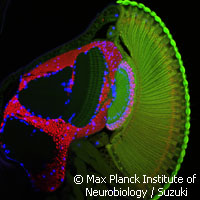Gene interaction keeps brain development and activity in check
Scientists have made a large step towards solving the puzzle of how a neuron knows exactly where it should grow and when it should contact another nerve cell. Researchers at the Max Planck Institute of Neurobiology in Germany have discovered that the interaction of two genes helps developing neurons understand when they've reached their target area in the fruit fly brain. Thanks to this research, presented in the journal Nature Neuroscience, researchers could determine similar mechanisms with the potential to influence the development of the vertebrate brain, effectively fuelling our understanding of certain developmental diseases. The nervous system is renowned for its complexity. Some 100 billion nerve cells make up the human brain, and they are responsible for connecting to specific other cells during the brain's development. Failure to do so will result in a dysfunctional organism. Each cell sets up connections to its neighbouring cells and then sends out a long connecting cable, the axon, to a different area of the brain. When it has reached its target, the axon links up with the local neurons. A processing chain materialises, enabling us to perform a number of activities like seeing and recognising a glass, and reaching out and taking hold of it. Failure to make the right connections will impair a person's ability to perform the activity from start to finish. In other words, neurons need to connect to their correct partner cells to ensure success. 'The establishment of well-defined synaptic connections between specific neurons is critical for information processing in the brain,' the authors write. 'Synapses are often arranged into structures that reflect a functional organisation of synaptic contacts. How do axons select their specific synaptic layer during development?' they ask. 'The mechanisms underlying the formation of synaptic layers are still unclear, although important molecular players have been identified.' The Max Planck scientists, along with colleagues from Kyoto University and the Japan Science and Technology Agency, studied how an axon realises when it should stop growing and start linking up with neighbouring cells. They investigated the function of genes that influence the development of the visual system of the fruit fly. The researchers found that the fruit fly's visual system can only develop when two genes collaborate: the genes that generate the proteins 'Golden Goal' and 'Flamingo'. Situated at the tip of a growing axon, these two proteins seemingly compile information about their environment from the surrounding tissue. The neurons' draw on this information to navigate their way around the brain and recognise their target area. In a nutshell, their research showed that disorder will result when one of the genes is inactive, or if there is a disparity in the genes' activity including an axon that stops growing before arriving at its target area. 'We assume that very similar mechanisms play a role also in other organisms - including humans,' says Takashi Suzuki from the Max Planck Institute of Neurobiology, senior author of the study. 'We are now a good way into understanding how to manipulate the cells in such a way that they are certain to reach their target area.' The findings could help researchers develop new ways to fight developmental diseases and guide regenerating nerve cells back to their old connection sites.For more information, please visit: Max Planck Institute of Neurobiology:http://www.neuro.mpg.de/english/index2.htmlKyoto University:http://www.kyoto-u.ac.jp/enJapan Science and Technology Agency:http://www.jst.go.jp/EN/Nature Neuroscience:http://www.nature.com/neuro/index.html
Countries
Germany, Japan



